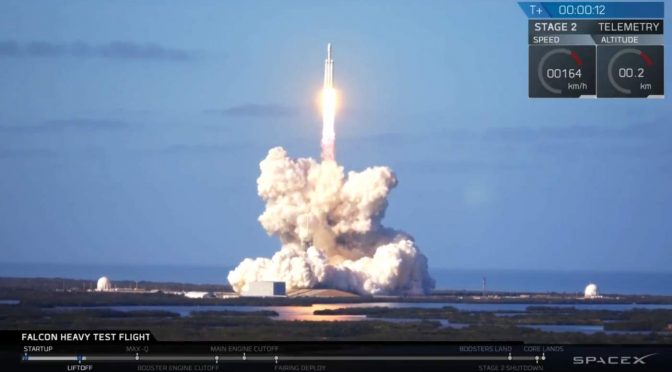On February 6, 2018, SpaceX successfully tested Falcon Heavy, the most powerful rocket that the American company ever built. When lifted off, it became also the most powerful operational rocket in the world. Powerful rockets like Falcon Heavy may one day carry humans to the Moon or Mars. But there might be an even more important use of powerful rockets like SpaceX’ Falcon Heavy and BFR, Blue Origin’s New Glenn or NASA’s SLS: asteroid mining.
Asteroid mining would shape our future economy and technology
Asteroid mining is the next big thing. It has the potential to shape our future economy and technology, and what’s more, one day it can save our planet.
But, to mine an asteroid, first, we have to get there. And we need powerful rockets to able to land on most asteroids, because of a measure called delta-v.
Delta-v is a measure of the impulse that is needed to perform a maneuver such as launch from, or landing on a planet or moon (or an asteroid, of course), or in-space orbital maneuver. The bigger an object’s delta-v is, the more thrust is required to get there.
Asteroids can have delta-vs from 4 km/s to almost 30 km/s (kilometers-per-second). Until Falcon Heavy, most of them are beyond our reach, because of their high delta-vs.

Ore-Bearing Asteroids
Not every asteroid is worth landing on it, because, only about 15% of them are ore-bearing, according to a presentation by Martin Elvis of the Harvard‐Smithsonian Center for Astrophysics. 10% of all asteroids are carbonaceous, 5% are metallic, and the remaining 85% are just rocky. What about water and platinum? 3% of all asteroids are water-rich, and 1% are platinum-rich.
According to Philip Metzger, a physicist/planetary scientist who works on technologies for mining the Moon, Mars, and asteroids, water is less obviously precious but it is super-important: water is the raw material for propellant. Launching water from Earth into space consumes a lot of propellants, which makes the whole concept self-defeating.
“Fortunately, water is abundant in space, where it is much easier to move around,” says Metzger. “A mining company will sell water to an in-space transportation company, which will use it to refuel a space tug parked in Earth orbit. The tug will dock with the newly launched satellite in the geostationary transfer orbit, and boost it to the final orbit quickly, within a day.”
There are about 300 water-rich near-Earth asteroids, each larger than 100 meters in diameter, or contains more than 30,000 Megatons (Mt) of water. With a price of $5 M/Mt ($5 for each 1 tonne of water), Elvis calculates the total market value of all these water-rich near-Earth asteroids is $50 trillion. But, most of them are beyond our reach, for now. Elvis says “our rockets limit the number of ore-bearing asteroids”. Only 3% of ore-bearing asteroids with delta-v less than 5 km/s are accessible now. But, with powerful rockets like Falcon Heavy or Blue Origin’s New Glenn, 45% of all ore-bearing asteroids will be accessible.

In the graph above, asteroid 101955 Bennu, a carbonaceous asteroid, has a Delta-V of 5.087 km/s, according to the Jet Propulsion Laboratory (JPL) (source). On 8 September 2016, NASA has launched The OSIRIS-REx (Origins, Spectral Interpretation, Resource Identification, Security, Regolith Explorer) asteroid study and sample-return mission, to study asteroid 101955 Bennu, and return a sample to Earth on 24 September 2023 for detailed analysis. While traveling to its destination, OSIRIS-REx took two amazing photos of Earth and Moon. First, 3 million miles (5 million kilometers) and then, 39.5 million miles (63.6 million kilometers) from Earth.

Sources
- “Asteroid Mining”, a presentation by Martin Elvis of Harvard‐Smithsonian Center for Astrophysics.
- “How Many Ore-Bearing Asteroids?” by Martin Elvis (Harvard‐Smithsonian Center for Astrophysics). Planetary & Space Science, in press 20 November 2013
- Delta-v on W
ikipedia - Falcon Heavy May Have Drastically Increased the Number of Asteroids We Can Mine on gizmodo.com
- Tsiolkovsky rocket equation on Wikipedia
- Study: OSIRIS-REx: Sample Return from Asteroid (101955) Bennu on arxiv.org
- Space Shuttle Endeavour’s Touchdown Meets Columbia’s Salute [An amazing photo from the past] - February 29, 2024
- Moon Landings: All-Time List [1966-2024] - February 23, 2024
- From Orbit to Ordinary: 10 Earthly Applications of Space Technology - January 23, 2024
